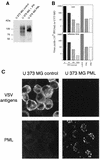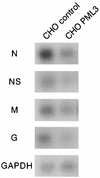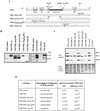Resistance to virus infection conferred by the interferon-induced promyelocytic leukemia protein
- PMID: 9444998
- PMCID: PMC124576
- DOI: 10.1128/JVI.72.2.1043-1051.1998
Resistance to virus infection conferred by the interferon-induced promyelocytic leukemia protein
Abstract
The interferon (IFN)-induced promyelocytic leukemia (PML) protein is specifically associated with nuclear bodies (NBs) whose functions are yet unknown. Two of the NB-associated proteins, PML and Sp100, are induced by IFN. Here we show that overexpression of PML and not Sp100 induces resistance to infections by vesicular stomatitis virus (VSV) (a rhabdovirus) and influenza A virus (an orthomyxovirus) but not by encephalomyocarditis virus (a picornavirus). Inhibition of viral multiplication was dependent on both the level of PML expression and the multiplicity of infection and reached 100-fold. PML was shown to interfere with VSV mRNA and protein synthesis. Compared to the IFN mediator MxA protein, PML had less powerful antiviral activity. While nuclear body localization of PML did not seem to be required for the antiviral effect, deletion of the PML coiled-coil domain completely abolished it. Taken together, these results suggest that PML can contribute to the antiviral state induced in IFN-treated cells.
Figures








Similar articles
-
Herpes virus induced proteasome-dependent degradation of the nuclear bodies-associated PML and Sp100 proteins.Oncogene. 1999 Jan 28;18(4):935-41. doi: 10.1038/sj.onc.1202366. Oncogene. 1999. PMID: 10023669
-
PML mediates the interferon-induced antiviral state against a complex retrovirus via its association with the viral transactivator.EMBO J. 2001 Jul 2;20(13):3495-505. doi: 10.1093/emboj/20.13.3495. EMBO J. 2001. PMID: 11432836 Free PMC article.
-
Role and fate of PML nuclear bodies in response to interferon and viral infections.Oncogene. 2001 Oct 29;20(49):7274-86. doi: 10.1038/sj.onc.1204854. Oncogene. 2001. PMID: 11704856 Review.
-
Interferon-induced antiviral Mx1 GTPase is associated with components of the SUMO-1 system and promyelocytic leukemia protein nuclear bodies.Exp Cell Res. 2001 Dec 10;271(2):286-95. doi: 10.1006/excr.2001.5380. Exp Cell Res. 2001. PMID: 11716541
-
Role of promyelocytic leukemia protein in host antiviral defense.J Interferon Cytokine Res. 2011 Jan;31(1):145-58. doi: 10.1089/jir.2010.0111. Epub 2011 Jan 3. J Interferon Cytokine Res. 2011. PMID: 21198351 Review.
Cited by
-
Interferon-induced degradation of the persistent hepatitis B virus cccDNA form depends on ISG20.EMBO Rep. 2021 Jun 4;22(6):e49568. doi: 10.15252/embr.201949568. Epub 2021 May 9. EMBO Rep. 2021. PMID: 33969602 Free PMC article.
-
Host genetic variation affects resistance to infection with a highly pathogenic H5N1 influenza A virus in mice.J Virol. 2009 Oct;83(20):10417-26. doi: 10.1128/JVI.00514-09. Epub 2009 Aug 12. J Virol. 2009. PMID: 19706712 Free PMC article.
-
K63-linked polyubiquitination of LGP2 by Riplet regulates RIG-I-dependent innate immune response.EMBO Rep. 2023 Feb 6;24(2):e54844. doi: 10.15252/embr.202254844. Epub 2022 Dec 14. EMBO Rep. 2023. PMID: 36515138 Free PMC article.
-
Overexpression of promyelocytic leukemia protein precludes the dispersal of ND10 structures and has no effect on accumulation of infectious herpes simplex virus 1 or its proteins.J Virol. 2002 Sep;76(18):9355-67. doi: 10.1128/jvi.76.18.9355-9367.2002. J Virol. 2002. PMID: 12186918 Free PMC article.
-
Promyelocytic leukemia protein mediates interferon-based anti-herpes simplex virus 1 effects.J Virol. 2003 Jun;77(12):7101-5. doi: 10.1128/jvi.77.12.7101-7105.2003. J Virol. 2003. PMID: 12768029 Free PMC article.
References
-
- Alber D, Staeheli P. Partial inhibition of vesicular stomatitis virus by the interferon-induced human 9-27 protein. J Interferon Cytokine Res. 1996;16:375–380. - PubMed
-
- Arnheiter H, Meier E. Mx proteins: antiviral proteins by chance or by necessity. New Biol. 1990;2:851–857. - PubMed
-
- Banerjee A K, Chattopadhyay D. Structure and function of the RNA polymerase of vesicular stomatitis virus. Adv virus Res. 1990;38:99–124. - PubMed
-
- Barlow P N, Luisi B, Milner A, Elliott M, Everett R. Structure of the C3HC4 domain by 1H-nuclear magnetic resonance spectroscopy. A new structural class of zinc-finger. J Mol Biol. 1994;237:201–211. - PubMed
Publication types
MeSH terms
Substances
Grants and funding
LinkOut - more resources
Full Text Sources
Other Literature Sources
Medical
Research Materials
Miscellaneous

